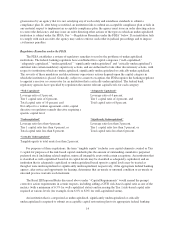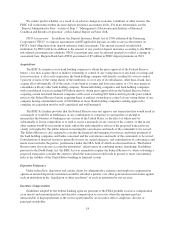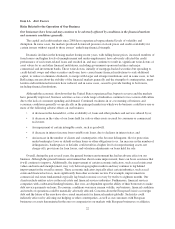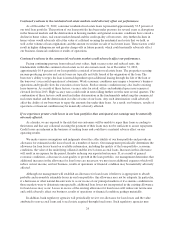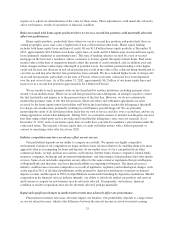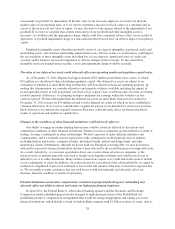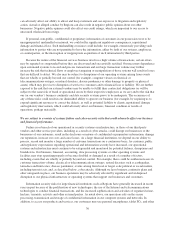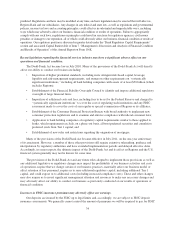Regions Bank 2012 Annual Report Download - page 40
Download and view the complete annual report
Please find page 40 of the 2012 Regions Bank annual report below. You can navigate through the pages in the report by either clicking on the pages listed below, or by using the keyword search tool below to find specific information within the annual report.Continued weakness in the residential real estate markets could adversely affect our performance.
As of December 31, 2012, consumer residential real estate loans represented approximately 33.5 percent of
our total loan portfolio. This portion of our loan portfolio has been under pressure for several years as disruptions
in the financial markets and the deterioration in housing markets and general economic conditions have caused a
decline in home values, real estate market demand and the credit quality of borrowers. Any further declines in
home values would adversely affect the value of collateral securing the residential real estate that we hold, as
well as the volume of loan originations and the amount we realize on sale of real estate loans. These factors could
result in higher delinquencies and greater charge-offs in future periods, which could materially adversely affect
our business, financial condition or results of operations.
Continued weakness in the commercial real estate markets could adversely affect our performance.
Facing continuing pressure from reduced asset values, high vacancy rates and reduced rents, the
fundamentals within the commercial real estate sector also remain weak. As of December 31, 2012,
approximately 10.4 percent of our loan portfolio consisted of investor real estate loans. The properties securing
income-producing investor real estate loans are typically not fully leased at the origination of the loan. The
borrower’s ability to repay the loan is instead dependent upon additional leasing through the life of the loan or
the borrower’s successful operation of a business. Weak economic conditions may impair a borrower’s business
operations and typically slow the execution of new leases. Such economic conditions may also lead to existing
lease turnover. As a result of these factors, vacancy rates for retail, office and industrial space may remain at
elevated levels in 2013. High vacancy rates could result in rents falling further over the next several quarters. The
combination of these factors could result in further deterioration in the fundamentals underlying the commercial
real estate market and the deterioration in value of some of our loans. Any such deterioration could adversely
affect the ability of our borrowers to repay the amounts due under their loans. As a result, our business, results of
operations or financial condition may be materially adversely affected.
If we experience greater credit losses in our loan portfolios than anticipated, our earnings may be materially
adversely affected.
As a lender, we are exposed to the risk that our customers will be unable to repay their loans according to
their terms and that any collateral securing the payment of their loans may not be sufficient to assure repayment.
Credit losses are inherent in the business of making loans and could have a material adverse effect on our
operating results.
We make various assumptions and judgments about the collectability of our loan portfolio and provide an
allowance for estimated credit losses based on a number of factors. Our management periodically determines the
allowance for loan losses based on available information, including the quality of the loan portfolio, economic
conditions, the value of the underlying collateral and the level of non-accrual loans. Increases in this allowance
will result in an expense for the period, thereby reducing our reported net income. If, as a result of general
economic conditions, a decrease in asset quality or growth in the loan portfolio, our management determines that
additional increases in the allowance for loan losses are necessary, we may incur additional expenses which will
reduce our net income, and our business, results of operations or financial condition may be materially adversely
affected.
Although our management will establish an allowance for loan losses it believes is appropriate to absorb
probable and reasonably estimable losses in our loan portfolio, this allowance may not be adequate. In particular,
if a hurricane or other natural disaster were to occur in one of our principal markets or if economic conditions in
those markets were to deteriorate unexpectedly, additional loan losses not incorporated in the existing allowance
for loan losses may occur. Losses in excess of the existing allowance for loan losses will reduce our net income
and could adversely affect our business, results of operations or financial condition, perhaps materially.
In addition, bank regulatory agencies will periodically review our allowance for loan losses and the value
attributed to non-accrual loans and to real estate acquired through foreclosure. Such regulatory agencies may
24


